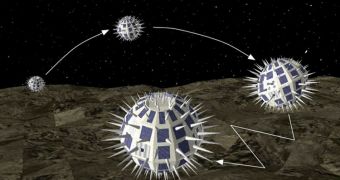A researcher in the United States says that exploring other planets and moons could be made easier by using swarms of robots that can literally hop on the surface of these celestial bodies. Hopping and bouncing are excellent ideas for exploring these locations on account of their low gravity.
Mars and the Moon, for example, have only a fraction of Earth's gravity. A hopping robot would bounce off the ground and land a very long distance away, enabling a swarm of such machines to cover a huge area after being deployed to the surface.
Working under the NASA Innovative Advanced Concepts (NIAC) Program, Stanford University assistant professor of aeronautics and astronautics Marco Pavone developed this remarkable idea while thinking about ways to explore objects such as the Martian moons, Phobos and Deimos.
Asteroids such as Vesta, protoplanets, dwarf planets like Ceres and Pluto, and small moons could all constitute perfectly valid targets for these robots. The machines could be deployed from a larger spacecraft, and could spring into action upon impact with the body's surface.
Pavone, who is also a research affiliate at the NASA Jet Propulsion Laboratory (JPL), in Pasadena, California, says that the robots would be small and spherical, and extremely resilient to impacts. However, this sturdiness would not influence their scientific capabilities.
He believes that the price tag associated with such a mission would be only a fraction of that currently needed to launch large-scale robotic explorers to other worlds, such as the Mars Science Laboratory.
An added benefit would be that losing one or more of these robots – regardless of the reason – would not imply the failure of the entire mission. All individual robots would communicate with each other, and with the spacecraft that deployed them to the surface.
Pavone believes that such robots could also be used to pave the way for more advanced missions, both manned and robotic. These swarms could be employed, for example, to find the most suitable landing sites for a spacecraft.
They could be deployed to an area targeted by a large mission. For instance, the system would have come in handy for NASA before launching the MSL, since the rover is now heading for Gale Crater, on Mars, without experts knowing too many details about the robot's landing site, Universe Today reports.

 14 DAY TRIAL //
14 DAY TRIAL //